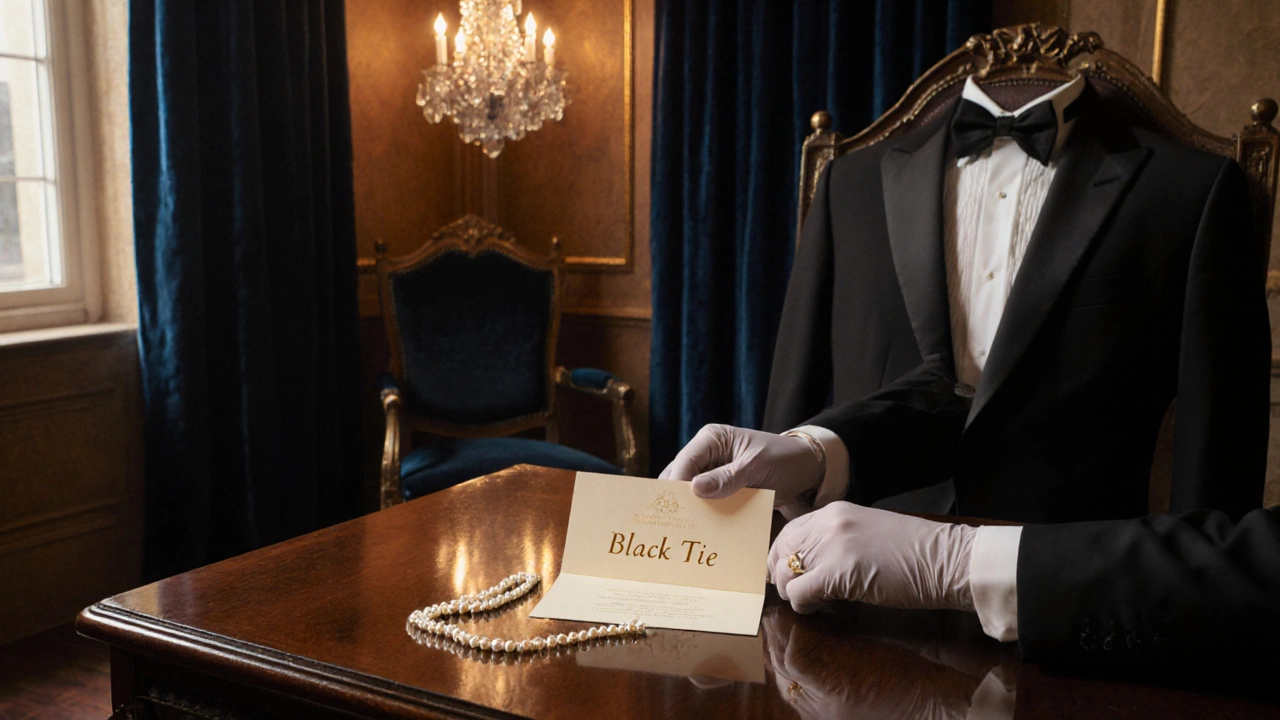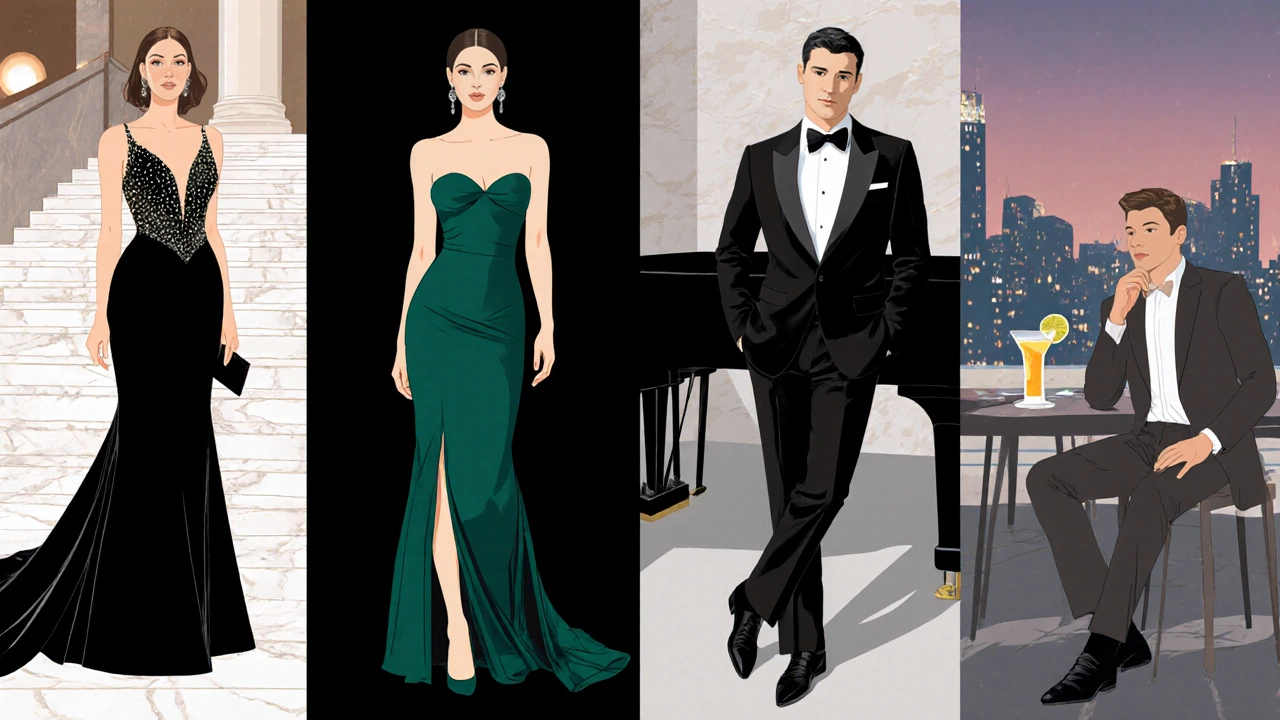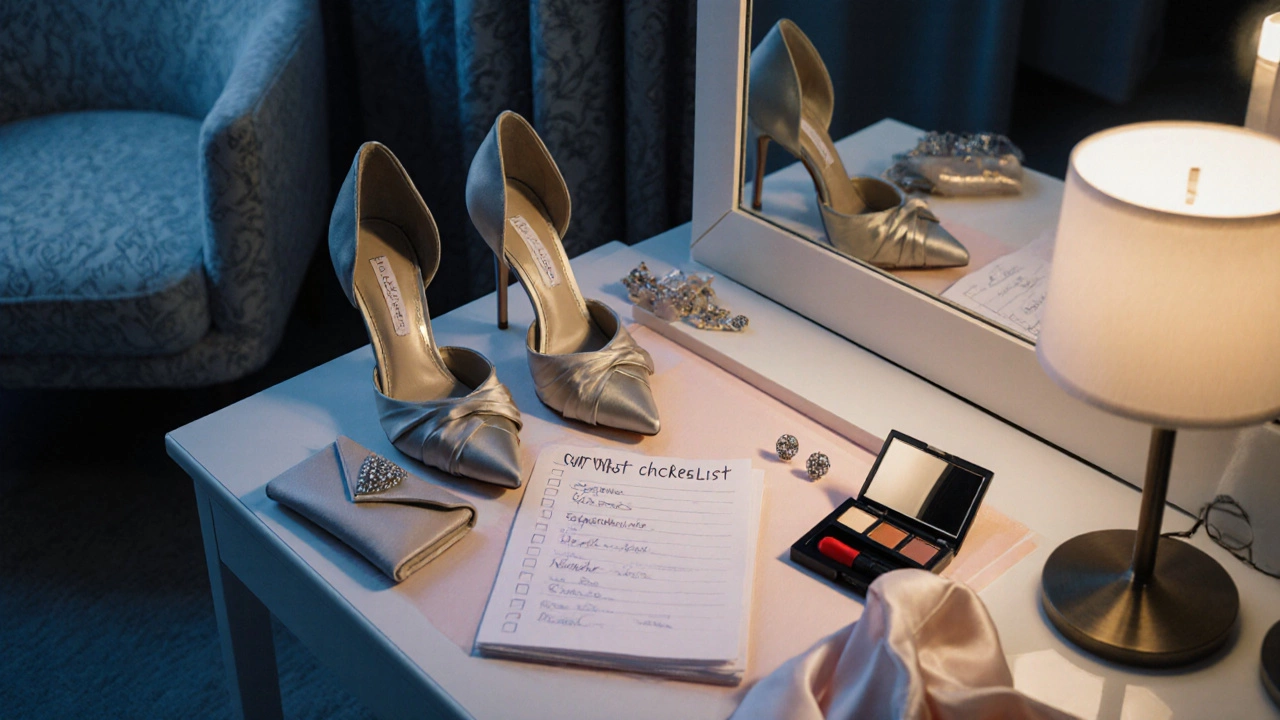Evening Wear Dress Code: Essential Rules & Tips

Evening Dress Code Checker
What's the Dress Code?
Select the dress code for your event to see recommended attire
Key Takeaways
- Know the four main evening dress codes: Black tie, Black tie optional, Formal, and Cocktail.
- Match dress length, fabric, and colour to the specific code.
- Accessorise wisely - less is more for stricter codes.
- Choose shoes that complement rather than dominate your outfit.
- Follow a quick checklist to avoid common pitfalls.
When you're invited to a gala or a fancy dinner, evening wear is the dress code that calls for polished, sophisticated outfits suitable for nighttime events. But the term can feel vague - is a cocktail dress acceptable? Do I need a tuxedo? This guide breaks down the rules, so you can walk into any venue feeling confident and appropriately dressed.
Understanding the Core Dress Codes
Evening events usually fall into one of four established codes. Knowing which one applies is the first step to getting your look right.
- Black tie requires a tuxedo for men and a full‑length floor‑sweeping gown for women.
- Black tie optional lets guests choose between a tuxedo or a dark suit, and a long gown or an elegant cocktail dress.
- Formal is slightly less strict than black tie, allowing dark suits and knee‑length dresses.
- Cocktail calls for knee‑to‑mid‑calf dresses for women and dress shirts with blazers for men.
Invitations usually spell out the code, but if they’re vague, look at the venue. Luxury hotels and opera houses tend toward black tie, upscale restaurants often go for cocktail, and corporate galas might specify formal.
Black Tie vs. Black Tie Optional vs. Formal vs. Cocktail
Here’s a quick visual comparison to help you decide what to wear.
| Dress Code | Typical Venues | Recommended Attire (Women) | Recommended Attire (Men) | Dress Length |
|---|---|---|---|---|
| Black tie | Opera, charity gala, upscale ballroom | Floor‑length evening gown | Tuxedo with bow tie | Full floor |
| Black tie optional | High‑end hotel events, award ceremonies | Long gown or elegant cocktail dress | Dark suit with tie or tuxedo | Long or knee‑length |
| Formal | Corporate dinners, upscale weddings | Knee‑length or midi dress | Dark suit with tie | Knee‑to‑mid‑calf |
| Cocktail | Trendy restaurants, art openings | Knee‑length cocktail dress | Dress shirt, blazer, optional tie | Knee |
Choosing the Right Dress: Evening Gown vs. Cocktail Dress
Both Evening gown is a full‑length dress made from luxurious fabrics like silk, chiffon, or velvet and Cocktail dress typically falls to the knee and uses lighter fabrics such as satin or lace have their place.
Use an evening gown when the invite says “black tie” or “black tie optional” and you want to make a dramatic entrance. Opt for a cocktail dress for “cocktail” or “formal” events where you want elegance without the full‑length drama.
Fit matters across both styles. Tailored silhouettes that highlight your shoulders or waist work better under spotlights. Avoid overly loose cuts that can look sloppy in low lighting.

Fabric, Colour, and Pattern: The Subtle Details
Fabric choice signals how formal an outfit feels. Heavier fabrics - silk satin, velvet, brocade - lean toward stricter codes. Lightweight chiffon or organza work well for cocktail and semi‑formal settings.
Colour rules have relaxed a bit in recent years, but classic guidance still holds:
- Black remains the safest for black‑tie events.
- Deep jewel tones (emerald, sapphire, burgundy) are welcome for cocktail and formal occasions.
- Metallics (gold, silver) can add sparkle, but keep them limited to accessories unless the event calls for “festive” attire.
- Avoid bright white or neon shades unless the host explicitly encourages a “themed” dress code.
Patterns such as subtle florals or fine glitter are acceptable for cocktail dresses, but stick to solid colours for full‑length gowns at black‑tie affairs.
Accessories: Less Is More (Unless You’re the Host)
Accessories should enhance, not overpower, your outfit. Here’s a quick rule‑of‑thumb per dress code:
- Black tie: Fine jewellery - diamond studs, a delicate necklace, or a single statement piece. A small clutch.
- Black tie optional: You can add a pop of colour with a cuff or bold earrings, but keep the look elegant.
- Formal: A classic watch, modest earrings, and a structured handbag.
- Cocktail: Feel free to experiment with statement jewellery or a patterned clutch.
Remember to match metal tones (gold with gold, silver with silver) and keep belts slim.
Shoes: Comfort Meets Class
Footwear should complement the dress length and venue floor. For evening gowns, a closed‑toe stiletto or a sleek pointed‑toe pump works well. If the event involves dancing, consider a slightly lower heel to avoid sore feet.
Cocktail dresses pair nicely with heeled sandals or kitten heels. Avoid overly casual shoes like flats or sneakers unless the invitation specifically says “smart casual”.
Make sure your shoes are broken in - a blister at a gala is a nightmare.

Makeup & Hairstyle: The Finishing Touches
Evening looks often call for a bit more drama than daytime. Aim for:
- Bold lip colour (classic red or deep berry) for black‑tie events.
- Smoky eye or defined eyeliner for added intensity.
- Hairstyles that stay in place - sleek updos, low buns, or soft waves secured with pins.
Keep your makeup balanced; if you go heavy on the eyes, choose a nude lip, and vice versa.
Common Pitfalls & How to Avoid Them
Even if you follow the rules, small missteps can ruin the look:
- Over‑accessorising: Too many bracelets or a heavy necklace can look cluttered.
- Wrong dress length: A floor‑length gown that drags on a carpet can be a tripping hazard.
- Clashing colours: Pair a bright dress with a neon clutch - it screams “I didn’t read the invite”.
- Uncomfortable shoes: You’ll spend the whole night wincing.
- Ignoring the venue: Outdoor garden parties may require a light shawl or wrap.
Double‑check the invitation, research the venue’s photos, and do a quick trial run at home before the big night.
Quick Checklist Before You Leave Home
- Confirm the dress code (black tie, black tie optional, formal, cocktail).
- Pick the appropriate dress style and length.
- Select fabric and colour that match the code.
- Choose shoes you’ve broken in.
- Limit jewellery to 1‑2 pieces.
- Do a hair and makeup trial.
- Pack a small emergency kit (stain remover, safety pins, double‑sided tape).
Frequently Asked Questions
Can I wear a black dress to a black‑tie event?
A black dress is fine only if it’s a full‑length evening gown made from luxurious fabric and paired with sophisticated accessories. A simple cocktail‑length black dress would be too short for black tie.
What if the invitation only says “dressy”?
Treat “dressy” as at least formal. Opt for a knee‑length dress or a dark suit and add a touch of sparkle with jewellery or a clutch.
Are sequins allowed at a cocktail event?
Yes, but keep them subtle. A sequin‑trimmed dress or a sparkly top works, as long as you balance it with simple shoes and jewellery.
Do men need to wear cufflinks for black‑tie optional?
Cufflinks are optional but add a refined touch. If you’re wearing a tuxedo, definitely wear them; with a dark suit, a polished tie is enough.
How far in advance should I break in my shoes?
At least a week. Wear them around the house, on short walks, and even on a quick outing to ensure they’re comfortable.
Is it okay to wear a bold coloured dress to a black‑tie event?
Traditionally black is safest, but deep jewel tones (emerald, ruby, navy) are now accepted, especially if the event is less rigid and you pair it with classic accessories.
- Oct, 19 2025
- Violet Greenfield
- 0
- Permalink
Written by Violet Greenfield
View all posts by: Violet Greenfield